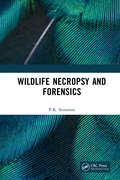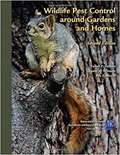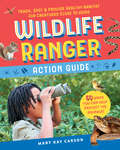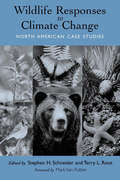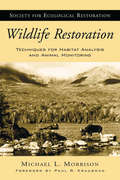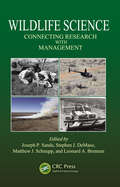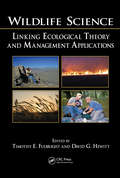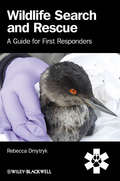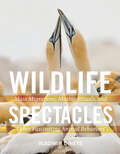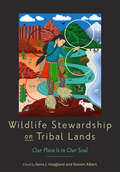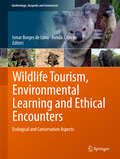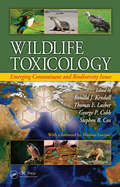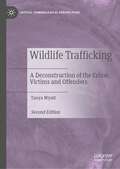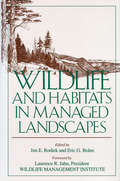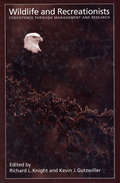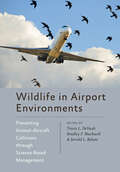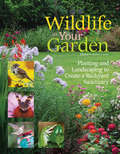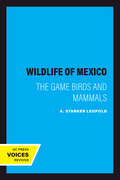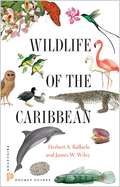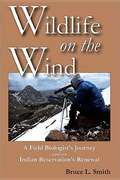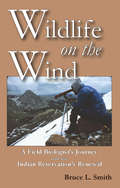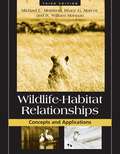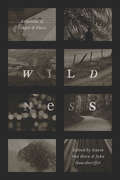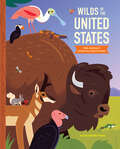- Table View
- List View
Wildlife Necropsy and Forensics
by P.K. SriramanThe book discusses various necropsy procedures for wild animals both for the disease investigation and forensic usage. The list of various wildlife crimes, the role of each member of wildlife crime team investigation in general and the role of pathologist in particular, (the forensic veterinary pathology)and the salient features of methodology of crime investigation is given. Information on the mistakes and omissions in forensic necropsy, negative necropsy, common errors committed by pathologist while performing forensic necropsy, postmortem appearances of common pathological conditions and estimation of age of some of the domestic animals and their foetuses is given for guidance. Various types of wounds, and the types of firearms and their terminology are also given for easy understanding about the wounds and fire arms.Note: T&F does not sell or distribute the Hardback in India, Pakistan, Nepal, Bhutan, Bangladesh and Sri Lanka.
Wildlife Pest Control around Gardens and Homes
by Terrell P. Salmon Desley A. Whisson Rex E. Marsh Robert E. LickliterWildlife Pest Control around Gardens and Homes by Terrell P. Salmon, Robert E. Lickliter
Wildlife Ranger Action Guide: Track, Spot & Provide Healthy Habitat for Creatures Close to Home
by Mary Kay CarsonAs concern for the welfare of species like honey bees and monarch butterflies grows alongside awareness of the impact of climate change, inspiring the next generation of citizen scientists is more important than ever. With Wildlife Ranger Action Guide, kids can make the world better for the animals and insects they love, starting right in their own backyards. Dozens of hands-on activities and habitat creation projects, such as making a frog pond from a kiddie pool, planting a pollinator garden for bees, painting a bat house, and building a lodge for lizards, encourage children to learn about and take an active role in protecting local wildlife. Lively photographic field guides covering 78 North American wildlife species teach kids about the habits and habitats of each and include tips for providing the plants and food needed for their survival. This publication conforms to the EPUB Accessibility specification at WCAG 2.0 Level AA.
Wildlife Responses to Climate Change: North American Case Studies
by Stephen H. Schneider Terry Root Mark Van PuttenWildlife Responses to Climate Change is an important addition to the body of knowledge critical to scientists, resource managers, and policymakers in understanding and shaping solutions to problems caused by climate change. It provides a useful resource for students and scientists studying the effects of climate change on wildlife and will assist resource managers and other wildlife professionals to better understand factors affecting the species they are striving to conserve.
Wildlife Restoration: Techniques for Habitat Analysis and Animal Monitoring (Science Practice Ecological Restoration #1)
by Michael L. Morrison Paul R. KrausmanWildlife Restoration links restoration ecology and wildlife management in an accessible and comprehensive guide to restoring wildlife and the habitats upon which they depend. It offers readers a thorough overview of the types of information needed in planning a wildlife-habitat restoration project and provides the basic tools necessary for developing and implementing a rigorous monitoring program. The book: explains the concepts of habitat and niche: their historic development, components, spatial-temporal relationships, and role in land management reviews how wildlife populations are identified and counted considers captive breeding, reintroduction, and translocation of animals discusses how wildlife and their habitat needs can be incorporated into restoration planning develops a solid justification for monitoring and good sampling design in restoration projects discusses and critiques case histories of wildlife analysis in restoration projectsThe author does not offer a "cookbook" approach, but rather provides basic tools for understanding ecological concepts that can be used to design restoration projects with specific goals for wildlife. He focuses on developing an integrated approach to large-scale landscape restoration. In addition, he provides guidance on where more advanced and detailed literature can be found.Wildlife Restoration sets forth a clear explanation of key principles of wildlife biology for the restorationist, and will allow wildlife biologists to bring the insights of their field to restoration projects. It is an essential source of information for everyone involved with studying, implementing, or managing wildlife restoration projects, including students, ecologists, administrators, government agency staff, and volunteer practitioners.
Wildlife Science: Connecting Research with Management
by Leonard A. Brennan Joseph P. Sands Stephen J. DeMaso Matthew J. SchnuppDespite the potential synergy that can result from basing management applications on results from research, there is a polarization of cultures between wildlife managers and wildlife researchers. Wildlife Science: Connecting Research with Management provides strategies for bridging cultural and communication gaps between these groups. The text covers the history of the longstanding disconnect, research and management entities, species case studies, management and policy case studies, and conclusions and future directions. The authors present case studies of both successful and failed interactions, providing a platform for discussion of the underlying issues. They examine current issues in wildlife science and management to explore real-world implications resulting from the research and management disconnect.
Wildlife Science: Linking Ecological Theory and Management Applications
by Timothy E. Fulbright and David G. HewittConsciously or not, wildlife managers generally act from a theoretical basis, although they may not be fully versed in the details or ramifications of that theory. In practice, the predictions of the practitioners sometimes prove more accurate than those of the theoreticians. Practitioners and theoreticians need to work together, but this proves di
Wildlife Search and Rescue: A Guide for First Responders
by Rebecca DmytrykRescuing wild animals in distress requires a unique set of skills, very different from those used in handling domestic animals. The equipment, degree of handling, the type of caging and level of care a wild animal receives can mean the difference between life and death. Wildlife Search and Rescue is a comprehensive guide on ‘best practices’ and suggested standards for response to sick, injured and orphaned wildlife. This valuable resource covers the fundamentals of wildlife rescue, from ‘phone to field’, including safe and successful capture strategies, handling and restraint techniques and initial aid. Wildlife Search and Rescue is a must have for anyone interested in knowing what to do when they are face to face with a wild animal in need, or for anyone involved in animal rescue. While the book focuses on wildlife native to North America, much of the information and many of the techniques are applicable to other species, including domestic dogs and cats. Visit www.wiley.com/go/dmytryk/wildlifeemergency to access the figures from the book.
Wildlife Spectacles: Mass Migrations, Mating Rituals, and Other Fascinating Animal Behaviors
by Vladimir DinetsEqual parts nature guide, adventure story, and coffee table book! People are captivated by wild animals—by their strength and their size and by the things they do to stay alive. In Wildlife Spectacles zoologist Vladimir Dinets dives deep into this wonder, allowing curious readers to discover just how spectacular wild animals can be. In the rich, fully illustrated pages you’ll discover the migration of gray whales along the Pacific coast, the dancing alligators of the Everglades, the synchronized blinking of fireflies near Tennessee, the swarms of feeding bats over the Mississippi River, the blue-glowing scorpions of the Southwest desert, hundreds of wintering tundra swans in New Jersey, and much more.
Wildlife Stewardship on Tribal Lands: Our Place Is in Our Soul
by Serra J. Hoagland and Steven AlbertThis groundbreaking book brings together Native American and Indigenous scholars, wildlife managers, legal experts, and conservationists from dozens of tribes to share their wildlife stewardship philosophies, histories, principles, and practices.Tribes have jurisdiction over some of the healthiest wild areas in North America, collectively managing over 56 million acres of land. This is no accident: in addition to a deep reverence for the land and a strong history of environmental stewardship, Native peoples implement some of the best fish and wildlife preservation and management practices on the continent. Wildlife Stewardship on Tribal Lands is the first comprehensive resource dedicated to the voices and expertise of Native scholars and wildlife professionals. In its pages, nearly one hundred Native and non-native wildlife conservationists, managers, and their collaborators share lessons to guide wildlife professionals in how best to incorporate native methods and how to work effectively with tribal stakeholders. The authors cover topics that include:• Guidelines for conducting research on tribal lands• Traditional ecological knowledge-based management models• The cultural and ecological importance of key species• Legal battles for treaty rights, management authority, and funding• First foods and food sovereignty • Fisheries and migratory bird management• Tribal perspectives on the Endangered Species Act• A history of modern fish and wildlife management on tribal landsThe content of this book is not limited to the invaluable reports of research findings, explications of methodologies, and case studies. Capturing oral histories and spiritual knowledge through interviews with tribal leaders and the work of Native artists and writers honors the holistic awareness of the land offered to readers of this unique volume. Ultimately, the contributors to Wildlife Stewardship on Tribal Lands demonstrate how tribal practices are pivotal guideposts for those seeking to protect and harness our natural resources in ways that can help reverse grievous biodiversity losses and ensure the health of our environment for future generations.Contributors: Scott Aikin, Steven Albert, John Antonio, Dale Becker, Bethany Berger, Kimberly Blaeser, Arthur Blazer, Michael Blumm, Michael Brydge, Ashley Carlisle, Frank Cerno Jr., Sally Carufel Williams, Guy Charlton, Samuel Chischilly, Bob Christensen, Gerald Cobell, Cody Desautel, Lauren Divine, Douglas W. Dompier, Ramona Emerson, Kari Eneas, James Fall, Julian J. Fischer, James R. Floyd, James Gensaw Sr., Michael I. Goldstein, Kim Gottschalk, Shaun Grassel, E. Richard Hart, Dylan R. Hedden-Nicely, Caleb Hickman, Serra J. Hoagland, Kraig Holmes, Nathan Jim, R. Roy Johnson, Jovon Jojola, Tamra Jones, Emily Sylvan Kim, Winona LaDuke, Stacy Leeds, Crystal Leonetti, Aaron P. Lestenkof, Chip Livingston, Lorraine Marquez Eiler, Eric Mellink, Paul I. Melovidov, Lara Mengak, Gary Paul Nabhan, Liliana Naves, Vern Northrup, nila northSun, Raymond E. Paddock III, Lizzy Pennock, Nicole Marie Pete, Aaron Poe, Georgiana Pongyesva, Ken Poynter, Mathis Quintana, Seafha Ramos, Janisse Ray, Vanessa L. Ray-Hodge, Amadeo Rea, Mitzi Reed, Marcie Rendon, Sarah F. Rinkevich, Bruce Robson, Andrea Rogers, Thomas C. Rothe, David E. Safine, Patty Schwalenberg, Kyle Secakuku, John Sewall, Todd Sformo, Richard T. Sherman, Ron Skates, Arthur M. Soukkala, Lawrence Stevens, Juliana Suzukawa, Julie Thorstenson, Gloria Tom, Christopher Tran, Craig van der Heiden, John Wheeler, Jessica Wiarda, Tiana Williams-Claussen.
Wildlife Tourism, Environmental Learning and Ethical Encounters
by Ronda J. Green Ismar Borges de LimaThis book outlines the status quo of worldwide wildlife tourism and its impacts on planning, management, knowledge, awareness, behaviour and attitudes related to wildlife encounters. It sets out to fill the considerable gaps in our knowledge on wildlife tourism, applied ecology, and environmental education, providing comprehensive information on and an interdisciplinary approach to effective management in wildlife tourism. Examining the intricacies, challenges, and lessons learned in a meaningful and rewarding tourism niche, this interdisciplinary book comprehensively examines the major potentials and controversies in the wildlife tourism industry. Pursuing an insightful, provocative and hands-on approach, it primarily addresses two questions: ‘Can we reconcile the needs of the wildlife tourism industry, biodiversity conservation, ecological learning and animal ethics issues?’ and ‘What is the Future of the Wildlife Tourism Industry?’. Though primarily intended as a research text, it also offers a valuable resource for a broad readership, which includes university and training students, researchers, scholars, tourism practitioners and professionals, planners and managers, as well as the staff of government agencies.
Wildlife Toxicology: Emerging Contaminant and Biodiversity Issues
by Ronald J. Kendall Stephen B. CoxUpdating the extremely successful Wildlife Toxicology and Population Modeling (CRC Press, 1994), Wildlife Toxicology: Emerging Contaminant and Biodiversity Issues brings together a distinguished group of international contributors, who provide a global assessment of a range of environmental stressors, including pesticides, environmental contaminant
Wildlife Trafficking: A Deconstruction of the Crime, Victims and Offenders (Critical Criminological Perspectives)
by Tanya WyattThis book provides a comprehensive, global exploration of the scale, scope, threats, and drivers of wildlife trafficking from a criminological perspective. Building on the first edition, it takes into account the significant changes in the international context surrounding these issues since 2013. It provides new examples, updated statistics, and discusses the potential changes arising as a result of COVID-19 and the IPBES 2019 report. It also discusses the shift in trafficking ‘hotspots’ and the recent projects that have challenged responses to wildlife trafficking. It undertakes a distinctive exploration of who the victims and offenders of wildlife trafficking are as well as analysing the stakeholders who are involved in collaborative efforts to end this devastating green crime. It unpacks the security implications of wildlife trade and trafficking and possible responses and ways to combat it. It provides useful and timely information for social and environmental/life scientists, law enforcement, NGOs, and policy makers.
Wildlife and Habitats in Managed Landscapes
by Eric Bolen Jon RodiekAmericans are having an increasing impact on the rural landscape as development further encroaches in former wilderness areas. This disruptive land use is causing a decline in wildlife and wildlife habitats. Wildlife and Habitats in Managed Landscapes presents a new strategy for solving this problem by redefining habitats to include the concept of landscape. Employing this strategy, natural resource managers apply tools of planning, management, and design to entire landscapes to meet the needs of both wildlife and humans.
Wildlife and Recreationists: Coexistence Through Management And Research
by Joanna Burger Daniel J. Decker Richard L. Knight Kevin Gutzwiller H. Ken Cordell Paul KerlingerWildlife and Recreationists defines and clarifies the issues surrounding the conflict between outdoor recreation and the health and well-being of wildlife and ecosystems. Contributors to the volume consider both direct and indirect effects of widlife-recreationist interactions, including: *wildlife responses to disturbance, and the origins of these responses *how specific recreational activities affect diverse types of wildlife *the human dimensions of managing recreationists *the economic importance of outdoor recreation *how wildlife and recreationists might be able to coexist The book is a useful synthesis of what is known concerning wildlife and recreation. More important, it addresses both research needs and management options to minimize conflicts.
Wildlife in Airport Environments: Preventing Animal–Aircraft Collisions through Science-Based Management (Wildlife Management and Conservation)
by Travis L. DeVault Bradley F. Blackwell Jerrold L. BelantA comprehensive overview of wildlife issues facing airports and how to minimize conflicts.Winner of the NWRC Publication Award of the National Wildlife Research CenterThe pilot watches the instrument panel and prepares for touchdown—a routine landing until a burst of birds, a coyote, or a herd of deer crosses the runway! Every year, pilots experience this tension and many aircraft come into direct contact with birds and other wildlife, resulting in more than one billion dollars in damage annually. The United States Federal Aviation Administration has recorded a rise in these incidents over the past decade due to the combined effects of more reporting, rebounding wildlife populations, and an increased number of flights. Wildlife in Airport Environments tackles the issue of what to do about encounters with wildlife in and around airports—from rural, small-craft airparks to major international hubs. Whether the problem is birds or bats in the flight path or a moose on the runway, the authors provide a thorough overview of the science behind wildlife management at airports. This well-written, carefully documented volume presents a clear synthesis for researchers, wildlife managers, and airport professionals. The book belongs in the hands of all those charged with minimizing the risks that wildlife pose to air travel.Wildlife in Airport Environments is the first book in the series Wildlife Management and Conservation and is published in association with The Wildlife Society.ContributorsMichael L. Avery, U.S. Department of AgricultureJerrold L. Belant, Mississippi State UniversityKristin M. Biondi, Mississippi State UniversityBradley F. Blackwell, U.S. Department of AgricultureJonathon D. Cepek, U.S. Department of AgricultureLarry Clark, U.S. Department of AgricultureTara J. Conkling, Mississippi State UniversityScott R. Craven, University of Wisconsin–MadisonPaul D. Curtis, Cornell UniversityTravis L. DeVault, U.S. Department of AgricultureRichard A. Dolbeer, U.S. Department of AgricultureDavid Felstul, U.S. Department of the InteriorEsteban Fernández-Juricic, Purdue UniversityAlan B. Franklin, U.S. Department of AgricultureSidney A. Gauthreaux Jr., Clemson UniversityMichael Lavelle, U.S. Department of AgricultureJames A. Martin, Mississippi State UniversityRebecca Mihalco, U.S. Department of AgriculturePaige M. Schmidt, U.S. Fish and Wildlife ServiceThomas W. Seamans, U.S. Department of AgricultureKurt C. VerCauteren, U.S. Department of AgricultureBrian E. Washburn, U.S. Department of Agriculture
Wildlife in Your Garden: Planting and Landscaping to Create a Backyard Sanctuary
by Karen LanierImagine a thriving garden in your backyard, bursting with vibrantly colored blooms and lush green leaves, shaded by tall trees. Now imagine the same garden, alive with buzzing and flapping and chirping and croaking. Imagine the ecological impact of encouraging natural pollinators. Imagine the excitement of watching your garden become a hub of activity and learning about all of its different visitors. For those who relish observing nature in action, planning a garden to attract certain types of wildlife can bring daily enjoyment right into the backyard.Inside Wildlife in Your Garden:How to deal with and even appreciate the insects in your gardenReptile and amphibian backyard visitors and how they can contribute to a healthy ecosystem"Birdscaping"-planning and planting with birds in mindA special section on hummingbirds that includes an illustrated guide to twelve common typesUsing binoculars and field guides to identify birds by sight and by callsDifferent types of pollination and the plants and food crops that depend on itButterfly metamorphosis and gardening for the different life stagesHow bats and moths take over pollination duties at nightLearning to coexist with four-legged furry friends who like to dig and forageNatural ways to protect your garden from pests and discourage harmful wildlife
Wildlife of Mexico: The Game Birds and Mammals
by A. Starker LeopoldThis title is part of UC Press's Voices Revived program, which commemorates University of California Press’s mission to seek out and cultivate the brightest minds and give them voice, reach, and impact. Drawing on a backlist dating to 1893, Voices Revived makes high-quality, peer-reviewed scholarship accessible once again using print-on-demand technology. This title was originally published in 1959.
Wildlife of the Caribbean (Princeton Pocket Guides)
by James Wiley Herbert RaffaeleThis is the first comprehensive illustrated guide to the natural world of the Caribbean islands. It contains 600 vivid color images featuring 451 species of plants, birds, mammals, fish, seashells, and much more. While the guide primarily looks at the most conspicuous and widespread species among the islands, it also includes rarely seen creatures―such as the Rhinoceros Iguana and Cuban Solenodon―giving readers a special sense of the region's diverse wildlife. <p><p> Each species is represented by one or more color photos or illustrations; details regarding its identification, status, and distribution; and interesting aspects of its life history or relationship to humans. In addition, an introductory section focuses on the unique characteristics of the Caribbean’s fauna and flora, the threats faced by both, and some of the steps being taken to sustain the area’s extraordinary natural heritage.
Wildlife on the Wind
by Bruce L. SmithIn the heart of Wyoming sprawls the ancient homeland of the Eastern Shoshone Indians, who were forced by the U. S. government to share a reservation in the Wind River basin and flanking mountain ranges with their historical enemy, the Northern Arapahos. Both tribes lost their sovereign, wide-ranging ways of life and economic dependence on decimated buffalo. Tribal members subsisted on increasingly depleted numbers of other big gamedeer, elk, moose, pronghorn, and bighorn sheep. In 1978, the tribal councils petitioned the U. S. Fish and Wildlife Service to help them recover their wildlife heritage. Bruce Smith became the first wildlife biologist to work on the reservation. Wildlife on the Wind recounts how he helped Native Americans change the course of conservation for some of America's most charismatic wildlife.
Wildlife on the Wind: A Field Biologist's Journey and an Indian Reservation's Renewal (G - Reference, Information And Interdisciplinary Subjects Ser.)
by Bruce L. SmithIn the heart of Wyoming sprawls the ancient homeland of the Eastern Shoshone Indians, who were forced by the U.S. government to share a reservation in the Wind River basin and flanking mountain ranges with their historical enemy, the Northern Arapahos. Both tribes lost their sovereign, wide-ranging ways of life and economic dependence on decimated buffalo. Tribal members subsisted on increasingly depleted numbers of other big game—deer, elk, moose, pronghorn, and bighorn sheep. In 1978, the tribal councils petitioned the U.S. Fish and Wildlife Service to help them recover their wildlife heritage. Bruce Smith became the first wildlife biologist to work on the reservation. Wildlife on the Wind recounts how he helped Native Americans change the course of conservation for some of America's most charismatic wildlife.
Wildlife-Habitat Relationships: Concepts and Applications
by Michael L. Morrison William Mannan Bruce MarcotWildlife-Habitat Relationships goes beyond introductory wildlife biology texts to provide wildlife professionals and students with an understanding of the importance of habitat relationships in studying and managing wildlife. The book offers a unique synthesis and critical evaluation of data, methods, and studies, along with specific guidance on how to conduct rigorous studies. Now in its third edition, Wildlife-Habitat Relationships combines basic field zoology and natural history, evolutionary biology, ecological theory, and quantitative tools in explaining ecological processes and their influence on wildlife and habitats. Also included is a glossary of terms that every wildlife professional should know. Michael L. Morrison is professor and Caesar Kleberg Chair in Wildlife Ecology and Conservation in the Department of Wildlife and Fisheries Sciences at Texas A&M University in College Station. Bruce G. Marcot is wildlife ecologist with the USDA Forest Service in Portland, Oregon. R. William Mannan is professor of wildlife ecology at the University of Arizona in Tucson.
Wildness: Relations of People & Place
by John Hausdoerffer Gavin Van Horn and John HausdoerfferWhether referring to a place, a nonhuman animal or plant, or a state of mind, wild indicates autonomy and agency, a will to be, a unique expression of life. Yet two contrasting ideas about wild nature permeate contemporary discussions: either that nature is most wild in the absence of a defiling human presence, or that nature is completely humanized and nothing is truly wild. This book charts a different path. Exploring how people can become attuned to the wild community of life and also contribute to the well-being of the wild places in which we live, work, and play, Wildness brings together esteemed authors from a variety of landscapes, cultures, and backgrounds to share their stories about the interdependence of everyday human lifeways and wildness. As they show, far from being an all or nothing proposition, wildness exists in variations and degrees that range from cultivated soils to multigenerational forests to sunflowers pushing through cracks in a city alley. Spanning diverse geographies, these essays celebrate the continuum of wildness, revealing the many ways in which human communities can nurture, adapt to, and thrive alongside their wild nonhuman kin. From the contoured lands of Wisconsin’s Driftless region to remote Alaska, from the amazing adaptations of animals and plants living in the concrete jungle to indigenous lands and harvest ceremonies, from backyards to reclaimed urban industrial sites, from microcosms to bioregions and atmospheres, manifestations of wildness are everywhere. With this book, we gain insight into what wildness is and could be, as well as how it might be recovered in our lives—and with it, how we might unearth a more profound, wilder understanding of what it means to be human.Wildness: Relations of People and Place is published in association with the Center for Humans and Nature, an organization that brings together some of the brightest minds to explore and promote human responsibilities to each other and the whole community of life. Visit the Center for Humans and Nature's Wildness website for upcoming events and a series of related short films.
Wilds of the United States: The Animals' Survival Field Guide
by Alexander VidalThe definitive guide to the wildlife of the United States.Do you know which animal evades rattlesnakes by dancing?Or that some squirrels can glide on the air for hundreds of feet?Or that alligators can create their own year-round pools?Put on your best pair of hiking boots, grab a sturdy walking stick, and explore the wild places of the United States with this stunning guidebook! Soak up new and shocking facts about this unexpected world of ours; pore over captivating, detail-rich illustrations; and discover surprising new creatures (some may be closer than you think!) every time you open the book. From glistening, snow-packed mountain ranges to searing deserts, this immersive and accessible guide is a one-stop shop for outdoor adventurers, animal enthusiasts, inquisitive minds—and anyone who listens to the call of the wild.WILD CREATURES OF THE US: Alexander Vidal tells the story of the wild creatures of the United States, offering accessible and fun visual cues like flags and badges to identify particular features in a gamified, graphic, and eye-catching way.ONE NATION: Focusing on the individual characteristics of different regions that collectively make up the rich, diverse, and unique place that is the United States, readers will be excited to both find their own hometowns and explore the places they've haven't been . . . yet! This book is perfect for fans of The 50 States!OUR UNIQUE ENVIRONMENT: A great way to introduce conversations about the unique environment of the United States. Teachers and librarians will find this the perfect addition to their curricula!FAMILY TRAVEL: Perfect for any family embarking on summer or spring break travel into the great outdoors, this engaging guide will inspire young adventurers and serve as the ideal gift for readers passionate about our wild environment.GIFT BOOK: With lush illustration and a hefty, deluxe package, this is a fantastic gift for anyone who is passionate about the environment, animals, and traveling—regardless of age! It's also perfect for fans of oversize nonfiction like Maps and Animalium!Perfect for:• Nature enthusiasts• Science teachers and educators• Families who love road trips or national parks• Children who love animals• Anyone looking for artful gift books
Wildvogelhaltung
by Werner Lantermann Jörg AsmusKlimawandel, Waldrodungen, Tierhandel und Buschmeat-Jagd setzen auch den freilebenden Vogelbeständen in aller Welt immer mehr zu und haben bereits bei vielen Arten zum deutlichen Rückgang im Freiland geführt – manche sind mittlerweile stark gefährdet oder stehen kurz vor der Ausrottung. Ein Instrument, um bestimmte Arten zumindest in Menschenobhut zu erhalten, ist die gezielte Nachzucht. Dabei kann es jedoch nicht um die standardisierte „Ziervogelzucht“ gehen, wie sie seit Jahrzehnten von bestimmten Vereinen und Verbänden propagiert wird. Vielmehr geht es um eine professionelle Erhaltungszucht, wozu das vorliegende Buch die notwendigen Grundlagen liefert. Für solche Erhaltungszuchtprojekte müssen die noch in Menschenobhut vorhandenen Wildvogelbestände lokalisiert, zusammengeführt und in Zuchtbüchern gemanagt werden. Dazu bedarf es einer engen Zusammenarbeit von Tiergärtnern, Tiermedizinern, Genetikern, Museumsornithologen und auch privaten Praktikern. Insgesamt 33 solcher Fachleute aus mehreren Professionen konnten als Autoren für dieses Buch gewonnen werden und liefern im ersten Teil zunächst die theoretischen Grundlagen für gezielte Erhaltungszuchtprojekte. Im zweiten Teil werden alle in Menschenobhut haltungsrelevanten Wildvogelarten im Hinblick auf adäquate Haltungsformen, ihre Ernährungsansprüche sowie Zuchtmöglichkeiten und -probleme besprochen.
